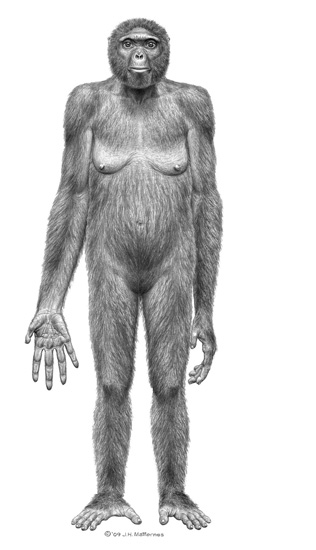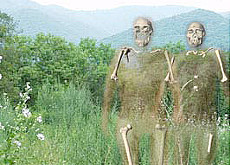Fossil find could be “missing link” to humans

The discovery of a near perfect ancient fossil skeleton may prove to be a vital piece in the jigsaw to discovering the roots of modern humans.
A team of researchers from Zurich University helped to uncover the skeletons in South Africa, that are said to be between 1.78 and 1.95 million years old. The find could re-write the history of human development.
At least five skeletons – two of them nearly perfectly formed – have so far been excavated from caves, with signs that there could be more. The newly discovered part ape, part human species has been named Australopithecus sebida.
The find has been hailed as the most significant since the skeleton of a three-million-year-old specimen, dubbed “Lucy”, was unearthed in Ethiopia in 1974. But while Lucy was ape-like, Australopithecus sebida could stand on two legs and has other humanoid features.
“To call Lucy the ‘missing link’ between apes and humans is a bad definition,” Peter Schmid, from Zurich University’s anthropology department, told swissinfo.ch. “The new find is a real link in the chain between Lucy and modern humans. It could be a real key in understanding the precursor to the Homo genus.”
The first bone was discovered by chance in 2008 after miners uncovered the site in the Malapa cave, situated on a game reserve north of Johannesburg. But the true importance of the find has only been put into perspective after two years of painstaking excavation and research.
Remarkably preserved
The bodies appear to have sunk quickly into the mud in the remote and sheltered spot. The remains were so well preserved that two skeletons – that of a young male and an adult female – were uncovered almost intact.
“We found preserved plant material among the bones and a tooth on one skeleton still had food remains on it,” said Schmid. “The levels of conservation were extraordinary, it is one of the most complete finds ever.”
“Cadavers usually lay on the ground after death, exposed to the elements and wild animals, until even the bone deteriorates.”
With such complete skeletons, researchers were able to piece together how Australopithecus sebida moved and lived. The strong, curved fingers, long arms and flexible feet suggested it was adapted for climbing.
But the length and structure of the leg bones also points to the species being able to stand upright on two legs.
Fitting the jigsaw together
“It quickly became apparent that the discovery was something new, unlike any remains previously found,” said Schmid, who was called in to examine the fossils along with other leading international experts. “It has a real mosaic of characteristics.”
It is now up to anthropologists to decide where Australopithecus sebida fits into the evolutionary scale and to determine if it is a direct ancestor of humans.
Australopithecinen hominids roamed Africa between four million years ago and around 1.4 million years ago when they became extinct. But the new specimen may yet have closer links to the Homo genus that includes modern humans.
“We may have to rethink a lot of our previous work,” said Schmid. “Lots of candidates for the missing link between apes and humans have been put forward before. They have usually been individual bones, but now we have complete skeletons, so we have a lot more to work with.”
In the meantime, the cave excavation work continues with the promise of finding yet more fossilised remains. For Schmid, the chance to take part in the groundbreaking discovery came because his team was already working on a nearby archeological site.
“I had been working in one cave site for 12 years and then, all of a sudden, I was presented with the treasures of the world,” he told swissinfo.ch
Matthew Allen, swissinfo.ch
The hominid classified as Australopithecinen includes the Australopithecus africanus, the Australopithecus afarensis and the Australopithecus garhi.
The newly found Australopithecus sebida is thought to be a direct descendent of Australopithecus africanus – the 40% complete skeleton of such a specimen, called Lucy, was found in Ethiopia in 1974.
It is thought that Australopithecinen developed into the Homo genus around two million years ago.
Australopithecus sebida has a head capacity of 420 cubic centimeters, smaller than africanus and with different facial features that are closer to the Homo genus.
The lower arms are long and ape-like while the finger bones are curved and have large points to attach muscle fibres, making them perfect for climbing.
The legs and feet are also adapted to climbing, but are also equipped to allow Australopithecus sebida to stand on two legs.
Subtle differences to the skeletal structure also hint that Australopithecus sebida could move around in a style more similar to the Homo genus than Australopithecus africanus.

In compliance with the JTI standards
More: SWI swissinfo.ch certified by the Journalism Trust Initiative













You can find an overview of ongoing debates with our journalists here . Please join us!
If you want to start a conversation about a topic raised in this article or want to report factual errors, email us at english@swissinfo.ch.